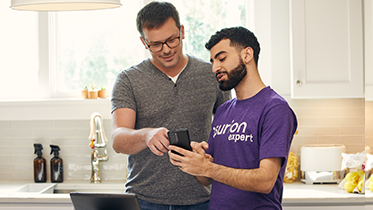From video calls with coworkers to streaming our favorite shows, we use our laptops to stay connected. So when there's no sound on your computer—and you have to shout, “Can you hear me?" into a void—it can be aggravating.
Fortunately, there are some easy ways to solve the problem. Here at Asurion, when tech breaks, we know how to fix it—whether it's an overheating laptop or a battery that won't charge. Here's our guide to why your sound may not be working on your Windows™ 10 laptop and how to get it back up and running.
Why is there no sound on my laptop?
There are several reasons your laptop's audio may not be working:
- The volume could be muted.
- The internal speakers could be malfunctioning.
- Windows may be sending sound to the wrong audio device.
- Audio enhancements may be causing a disruption.
- An operating system update may be conflicting with the audio drivers.
We'll walk you through the troubleshooting process.
How to fix Windows 10 audio issues
Is your computer audio not working? We'll get you back up and running. Our tips cover what to do if your sound isn't working on Windows 10.
Check volume
No shame—everyone occasionally forgets to unmute. So your first step should be to click the Speaker icon in the bottom-right corner of the taskbar and make sure your volume is on and turned up.
Try headphones
Plug headphones or a headset into the headphone port in your computer. If the audio works, obviously, you've got sound. You'll also know the problem is with your laptop's built-in speakers.

You can’t work when your computer doesn’t want to
Get it repaired fast at one of our stores. Just stop in or make an appointment⎯we'll handle the rest.
Change audio devices
No audio on Windows? Your operating system may be sending sound to the wrong audio output device. Here's how to fix it:
- Right click the Speaker icon in the bottom-right corner of the taskbar.
- Click Open Sound settings.
- Scroll down to Related Settings and click Sound Control Panel.
- Select the Playback tab, and click the device you want to set as your default.
- Click the Set Default button at the bottom of the window, then click OK.
If the audio device you want to use isn't there, here's what to do:
- In the Sound Control Panel window, right-click and check Show Disabled Devices.
- Select your preferred audio device.
- Click the Set Default button, then click OK.
If you don't know which device you want to use, select one at a time. When the sound works, you have a winner.
Disable audio enhancements
When your computer's sound isn't working, one crucial troubleshooting step is to disable any active audio enhancements, which are built-in features that can improve and customize certain aspects of your audio experience. Here's how to turn off these features:
- In the Windows search bar, type Control Panel and click it.
- Click Hardware & Sound.
- Click Sound.
- Click the Playback tab.
- Right click the desired audio device.
- Click Properties.
- Click the Enhancements tab.
- Click the checkbox to Disable all enhancements or Disable all sound effects.
- Click OK, then play audio to test your sound.
- If that doesn't work, select another audio device and repeat the process.
Install or update audio drivers
Is there still no sound on your laptop or computer? Try updating the drivers—the software that allows your PC to communicate with its hardware. Here's how:
- In the Windows search bar, type Device Manager and click it.
- Click the arrow next to Sound, video and game controllers.
- Right click the desired audio device from the options and select Update driver.
- Select Search automatically for drivers, then follow the onscreen prompts.
If you have a device equipped with IDT High-Definition audio, you may need to update the drivers associated with it. Follow these steps to update the drivers.
- Click the arrow next to Sound, video and game controllers.
- Right click the IDT High Definition Audio CODEC device from the options and click Update driver.
- Click Browse my computer for drivers.
- Click Let me pick from a list of available drivers on my computer.
- Select High Definition Audio Device from the list and click Next.
Run audio troubleshooter
If nothing else has worked so far, it's time to try restarting your audio services. These are the settings that manage audio on Windows-based programs. Here's how:
- In the Windows search bar, type Services and click it.
- Locate Windows Audio and right click it.
- Click Restart.
If you still have no sound, run the Audio Troubleshooter, which may automatically fix your laptop's audio problems.
- In the Windows search bar, type audio troubleshooter and click Find and fix problems with playing sound.
- Select the issue you want to troubleshoot and follow the onscreen prompts.
If you've tried these steps and still need a little help, we're right around the corner. Schedule a repair at the nearest uBreakiFix® by Asurion store and our certified experts can get your device back up and running as soon as the same day.





